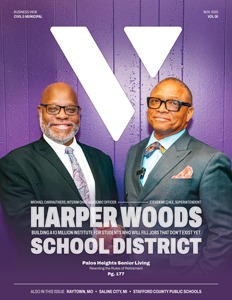Building America’s Future Workforce
Partnerships, Purpose, and the Power of Skills
In an era defined by rapid technological change and widening workforce gaps, few organizations are as deeply embedded in shaping America’s skilled trades pipeline as SkillsUSA. With more than 444,000 student and teacher members across all 50 states, two territories, and Washington D.C. SkillsUSA is bridging the divide between education and industry — preparing students to be not only job-ready, but career-ready day one.
“Our mission has always been to equip students with the skills and confidence they need to succeed,” says Chelle Travis, Executive Director of SkillsUSA. “We can’t do that without our business and industry partners. It takes collaboration among education, government, and employers to make SkillsUSA what it is today — the number one workforce development organization for students in the nation.”
A Legacy of Leadership and Transformation
The organization’s roots date back more than 60 years, originally known as the Vocational Industrial Clubs of America (VICA). Two and a half decades ago, as the economy evolved and “vocational education” gave way to career and technical education (CTE), VICA rebranded as SkillsUSA — signaling a renewed focus on empowering students to pursue skilled careers as a first choice rather than a fallback option.
Travis recalls that moment as pivotal. “There was a huge national effort to change the perception of skilled trades,” she says. “We wanted students, parents, and educators to see CTE not as a second choice, but as a respected, valuable, and essential pathway to a family-sustaining career.”
That cultural shift has proven prescient. Today, the U.S. faces an estimated 2.1 million unfilled manufacturing jobs and half a million openings in construction. SkillsUSA’s mission — to empower students to become skilled professionals, career-ready leaders, and responsible community members — is more vital than ever.
Connecting Education and Industry
SkillsUSA operates through a nationwide network of state associations and local chapters, where students gain hands-on experience in more than 130 occupational areas, from welding and construction to 3D animation, culinary arts, and public safety.
Each chapter implements a Program of Work, a practical guide that helps students develop personal, workplace, and technical skills grounded in academics that built on the SkillsUSA Framework — 17 essential elements identified by over 1,000 business and industry partners as critical for workplace success.

“Everything we do is informed by industry,” Travis explains. “Our partners tell us the skills they need in entry-level employees, and we embed those directly into curriculum, competitions, and certification standards. That’s the SkillsUSA difference.”
These partnerships aren’t symbolic. Companies like 3M, Lowe’s, Ford, Aerotek, Constellation Energy, BASF, and Haas provide equipment, scholarships, mentorship, and even job offers to students who compete at SkillsUSA events. Many leave national or state competitions with employment offers in hand.
“We have over 850 national business and industry partners,” Travis adds. “They believe in our mission and actively remove barriers for students — from scholarships to work-based learning to direct hiring pipelines.”
3M: A Model Partner
One of those partners is 3M, which has been working with SkillsUSA for decades. Maureen Tholen, Vice President of Sustainability for 3M’s Safety and Industrial Business Group and immediate past president of the SkillsUSA Board of Directors, says the relationship is a natural fit.
“At 3M, many of our products — abrasives, adhesives, personal protective equipment — serve the same industries SkillsUSA trains for,” Tholen explains. “It’s an authentic connection between education and real-world application.”
For 3M, the partnership isn’t just about outreach; it’s a strategic investment in the workforce of tomorrow. “Reaching the education segment is difficult for most companies,” Tholen notes. “SkillsUSA gives us a way to connect with students and educators early, building familiarity, trust, and awareness of career possibilities.”
3M employees also volunteer as mentors and judges, donate materials for competitions, and help align industry standards with training. “There are so many levels of engagement,” Tholen adds. “Advocacy, mentorship, product support — all of it helps prepare students and strengthens the talent pipeline.”
Students Finding Purpose
For Hannah Castillo, a national officer and SkillsUSA Region IV Vice President, the organization has been life-changing.
“I first joined SkillsUSA because I was interested in law and public safety,” she says. “It was the only program at my school that offered hands-on experience — and it changed my life.”
Through competition and leadership opportunities, Castillo learned to manage projects, collaborate under pressure, and build confidence — skills that go beyond the classroom.

Her chapter participated in community fundraisers, turkey drives with local police, and training partnerships with agencies like the FBI. “It’s about finding purpose and belonging,” Castillo explains. “I’ve made connections and gained experiences that I never thought were possible.”
As a national officer, she now helps lead initiatives on advocacy, marketing, and alumni engagement. Her team produces bilingual podcasts, develops financial management resources for local chapters, and expands outreach to Gen Z audiences.
“Our goal is to make SkillsUSA accessible, relatable, and inclusive,” she says. “We’re excited about growing membership to one million by 2030 — and we’re already building the foundation to make that happen.”
Bridging the Gap: From Classroom to Career
SkillsUSA’s impact reaches far beyond competitions and conferences. Its programs directly address the nation’s labor shortages by preparing roughly 100,000 graduates each year who are “career-ready day one.”
Through scholarships like Aerotek’s Make Your Mark (nearly $1 million in awards annually) and events such as SkillsUSA Signing Day, students are celebrated for choosing skilled career paths — much like athletes committing to college programs.
Meanwhile, digital initiatives like SkillsUSA Pathful are expanding access to professional networks and job-shadowing opportunities, allowing students in rural or underserved areas to connect virtually with employers nationwide.
“It doesn’t matter where you live or what your background is,” says Travis. “We’re bringing the nation’s top industry partners right to the local classroom.”
AI, Automation, and the Future of Work
As artificial intelligence and automation reshape industries, SkillsUSA’s leadership remains confident — and realistic — about what comes next.
“People fear that AI will eliminate jobs,” Tholen observes. “But in reality, it’s changing them. It’s creating demand for new technical skills and amplifying the importance of human skills — communication, collaboration, adaptability.”
Travis agrees. “AI and automation don’t reduce the need for skilled trades — they increase it,” she says. “From data centers to renewable energy, we’re seeing even greater demand for electricians, HVAC technicians, and construction professionals. SkillsUSA and our partners are working together to ensure students are ready for that future.”
Looking Ahead
Travis outlines that as the organization moves forward, SkillsUSA’s Drive to 65 strategic plan sets bold priorities that encompass growing its membership to 1 million by 2030, expanding access to middle-school programs, introducing career awareness earlier as well as transforming the National Leadership & Skills Conference (NLSC) into a global hub for CTE innovation and policy discussion.
She adds that the SkillsUSA will also be working towards advancing a digital ecosystem, integrating data, partnerships, and certification opportunities and it will continue to advocate for CTE funding and workforce alignment at both state and federal levels.

“Our goal is to be the convening force for workforce development in America,” says Travis. “We’re not just responding to the skills gap — we’re solving it.”
Empowering the Next Generation
With 850 industry partners, 100,000 graduates each year, and a rapidly expanding digital reach, SkillsUSA’s influence continues to grow. Its model — uniting students, educators, and employers under a shared mission — is proving essential to the nation’s economic future.
As Tholen puts it: “This isn’t just about filling jobs. It’s about creating pathways for success, dignity, and purpose.”
For students like Castillo, the impact is deeply personal. “SkillsUSA gave me the confidence to lead, to connect, and to see myself in a career I love,” she says. “It’s not just an organization — it’s a family that builds futures.”
AT A GLANCE
Who: SkillsUSA
What: A leading educational and workforce focused organization that bridges the gap between learning and industry needs
Website: www.skillsusa.org

